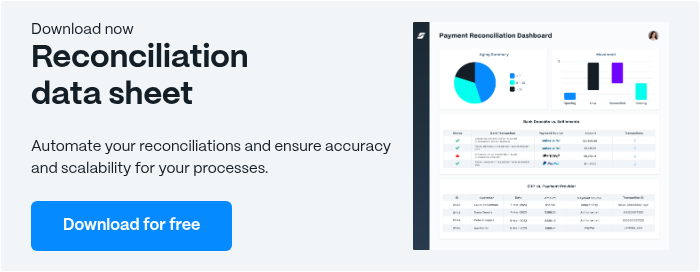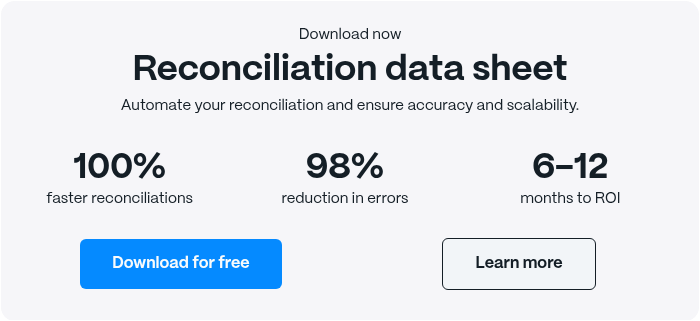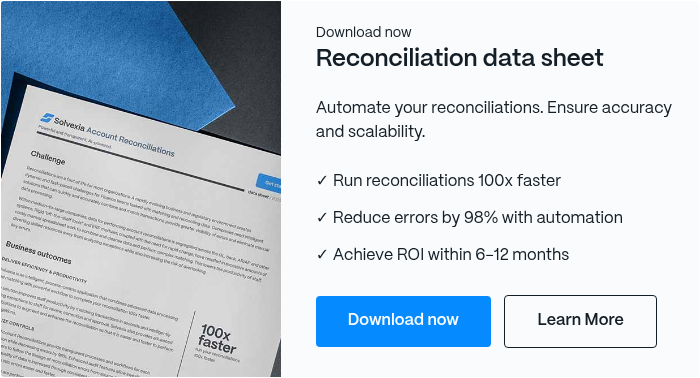End of Day Reconciliation for Financial Health: A Step-by-Step Guide

End of day reconciliation isn't just a mundane accounting task—it's the linchpin of financial integrity. Often overlooked, this daily practice can make or break your business's financial health. Whether you're a small business owner or a seasoned CFO, mastering end of day reconciliation is crucial for accurate reporting, fraud prevention, and informed decision-making.
In this guide, we'll cut through the complexity, showing you how to perfect your reconciliation process, overcome common challenges, and leverage modern tools for maximum efficiency. Ready to transform your financial oversight? Let's dive in.
Coming Up
What is End of Day Reconciliation?
End of day reconciliation is a crucial financial process that businesses perform at the close of each business day. It involves verifying and balancing all financial transactions that occurred during the day, ensuring that recorded figures match actual money movements.
At its core, end of day reconciliation is about accuracy and accountability. It's the process of comparing two sets of records to ensure they agree, typically involving:
- Comparing sales data from the point-of-sale (POS) system with actual cash and card payments received
- Verifying bank deposits against recorded sales
- Checking cash drawer counts against system-recorded cash transactions
This daily reconciliation process is a key component of broader financial reconciliation practices. It feeds into larger accounting processes, providing a foundation for accurate financial reporting, budgeting, and decision-making.
End of day reconciliation also plays a vital role in the audit process. By maintaining daily accuracy, businesses create a clear trail of financial activity that can be easily reviewed during internal or external audits. This daily diligence significantly simplifies month-end and year-end reconciliations, making the overall financial management process more efficient and reliable.
Whether it's cash reconciliation to verify physical currency handling, or bank reconciliation to ensure all electronic transactions are accounted for, end of day reconciliation is an essential practice for maintaining financial integrity and detecting any discrepancies or potential issues early.
Importance of End of Day Reconciliation in Financial Health
End of day reconciliation plays a crucial role in maintaining the financial health of a business. This daily practice ensures that all sales and transactions are accurately accounted for, creating a solid foundation for financial stability and informed decision-making.
Alignment of Financial Data
One of the primary benefits of end of day reconciliation is the alignment it provides between various financial data points:
- Cash on Hand: By counting the cash in registers and comparing it to recorded cash sales, businesses can ensure that physical currency matches expected amounts.
- Bank Deposits: Reconciling bank deposits against daily sales helps verify that all electronic transactions have been properly processed and recorded.
- POS System Reports: Comparing point-of-sale system reports with actual sales figures helps identify any discrepancies in digital record-keeping.
This three-way check between cash, bank records, and POS reports creates a comprehensive view of daily financial activity, leaving little room for errors or oversights.
Error Detection and Fraud Prevention
Daily reconciliation serves as an early warning system for financial discrepancies. By comparing different data sources each day, businesses can quickly spot:
- Calculation errors
- Data entry mistakes
- Suspicious transactions that might indicate fraud
The regularity of this process means that any issues are caught early, preventing small problems from snowballing into larger financial concerns.
Impact on Financial Reporting
Accurate daily reconciliation has a significant positive impact on overall financial reporting:
- Reliable Financial Statements: With daily checks in place, the data feeding into weekly, monthly, and annual financial statements is more likely to be accurate and trustworthy.
- Simplified Audits: Regular reconciliation creates a clear audit trail, making both internal and external audits smoother and more efficient.
- Improved Cash Flow Management: Understanding daily cash positions helps businesses make more informed decisions about short-term cash needs and long-term financial planning.
Cash Drawer Reconciliation
A key component of end of day reconciliation is reconciling cash drawers. This process involves:
- Counting the cash in each drawer
- Comparing the count to expected amounts based on sales records
- Investigating and resolving any discrepancies
This detailed attention to cash handling not only prevents losses but also helps in training staff and improving cash management procedures.
By prioritizing end of day reconciliation, businesses create a culture of financial accuracy and accountability. This daily practice might seem time-consuming, but it’s an investment that pays dividends in terms of financial health, accuracy, and peace of mind.
Preparing for End of Day Reconciliation
Effective preparation is key to smooth end-of-day reconciliation. Here's how to set yourself up for success:
- Organize Documentation: Keep sales receipts, POS reports, and bank deposit slips in order throughout the day.
- Manage Cash Drawers: Maintain a standard float and document any cash added or removed during the day.
- Prepare Digital Systems: Ensure POS systems and credit card terminals are ready for end-of-day reporting.
- Track Expenses: Collect and categorize all daily expense receipts.
- Communicate with Staff: Brief team members on accurate transaction recording and reporting discrepancies.
- Create a Checklist: Use a standardized list of items needed for reconciliation to ensure consistency.
- Schedule Wisely: Allocate uninterrupted time for the reconciliation process, preferably during quieter periods.
By implementing these steps, you'll streamline your reconciliation process, improving accuracy and efficiency. Remember, good preparation is the foundation of solid financial management.
Overcoming Manual Reconciliation Challenges with Automation
While end of day reconciliation is crucial for financial health, it's not without its challenges. Many businesses still rely on manual processes, which can lead to a range of issues. However, the rise of automation tools is transforming this landscape, offering solutions to long-standing reconciliation problems.
Challenges of Manual Reconciliation
- Data Entry Errors: Human error is inevitable in manual data entry. Transposing numbers, misplacing decimal points, or simply typing the wrong figure can lead to significant discrepancies.
- Missed Transactions: In a busy business environment, it's easy for transactions to be overlooked, especially if they're small or occur near closing time.
- Misinterpreted Receipts: Illegible handwriting, smudged receipts, or confusing notations can lead to incorrect interpretations of sales data.
- Time-Consuming Process: Manual reconciliation is labor-intensive, often requiring hours of work that could be better spent on strategic tasks.
- Inconsistent Practices: Without a standardized system, different employees might follow varying reconciliation practices, leading to inconsistencies.
How Automation Solves These Challenges
Automation tools, such as those offered by Solvexia, are revolutionizing the reconciliation process. Here's how:
- Reduced Data Entry Errors: Automated systems can directly import data from POS systems, bank statements, and other financial sources, eliminating manual data entry and its associated errors.
- Comprehensive Transaction Capture: Automated tools can track and reconcile all transactions in real-time, ensuring nothing is missed.
- Improved Data Interpretation: Advanced OCR (Optical Character Recognition) technology can accurately read and interpret receipts and invoices, reducing misinterpretation issues.
- Time Efficiency: What once took hours can now be accomplished in minutes, freeing up staff for more value-added activities.
- Standardized Processes: Automation enforces consistent reconciliation practices across the organization, ensuring uniformity and reliability.
- Real-Time Insights: Many automation tools offer dashboard views of financial data, allowing for immediate identification of discrepancies or unusual patterns.
- Enhanced Audit Trails: Automated systems maintain detailed logs of all reconciliation activities, simplifying audit processes and improving transparency.
Implementing Automated Reconciliation: Best Practices
To make the most of automated reconciliation tools:
- Choose a solution that integrates with your existing financial systems.
- Ensure proper staff training on the new tools.
- Start with a pilot program before full implementation.
- Regularly review and update automation rules to reflect changing business needs.
- Maintain human oversight to interpret results and handle exceptions.
By addressing these common challenges through automation, businesses can significantly improve their reconciliation processes. This not only reduces accounting errors but also provides more accurate, timely financial data for decision-making. As technology continues to evolve, embracing automated reconciliation is becoming less of a luxury and more of a necessity for efficient financial management.
Steps for Effective End of Day Reconciliation
Performing a thorough end of day reconciliation is crucial for maintaining accurate financial records. Follow these steps to ensure a comprehensive and effective reconciliation process:
- Gather All Necessary Reports and Documents
- Collect all sales receipts for the day
- Print or access the day's POS system report
- Obtain bank deposit slips and credit card batch reports
- Retrieve any relevant invoices or expense receipts
- Count and Record Cash
- Count all cash in the register(s)
- Document the total cash amount
- Compare this to the expected cash amount based on the POS cash sales report
- Reconcile Credit Card Transactions
- Review the credit card batch report
- Compare it with the POS system's credit card sales data
- Ensure that the total matches and that each transaction is accounted for
- Verify POS Data
- Review the POS system's daily sales report
- Ensure it includes all transactions for the day
- Cross-reference with individual sales receipts if necessary
- Compare Totals
- Add up the cash count and credit card batch total
- Compare this sum to the total sales reported by the POS system
- The two figures should match
- Investigate and Resolve Discrepancies
- If there are any differences, investigate the cause
- Check for data entry errors, missed transactions, or voided sales
- Review security camera footage if necessary for cash discrepancies
- Prepare Bank Deposit
- Count out the cash for bank deposit, leaving the float for the next day
- Prepare the deposit slip, ensuring it matches the amount to be deposited
- Record Any Adjustments
- Document any discrepancies found and the reasons for them
- Make necessary adjustments in your accounting system
- Generate and File Reconciliation Report
- Create a daily reconciliation report summarizing all findings
- Include total sales, cash count, credit card totals, and any discrepancies
- File this report for future reference and auditing purposes
- Prepare for Next Day
- Ensure the cash float for the next business day is in place
- Clean and organize the point of sale area
- Securely store all financial documents and reports
- Regular Review and Process Improvement
- Periodically review your reconciliation process for efficiency
- Identify recurring issues and implement solutions
- Consider automating parts of the process to reduce errors and save time
By following these steps consistently, you'll establish a robust sales reconciliation process that ensures accuracy in your financial records. This meticulous approach to cash reconciliation and POS reconciliation will help detect and prevent errors, deter fraud, and provide a clear picture of your daily financial activities.
Remember, while these steps provide a solid framework, you may need to adjust them to fit your specific business needs and systems. The key is to maintain consistency and thoroughness in your end of day reconciliation routine.
Managing Cash Flow for Efficient Reconciliation
Effective cash flow management is essential for efficient reconciliation. This includes monitoring cash transactions throughout the day, ensuring that all cash sales are recorded accurately, and maintaining a clear record of all cash movements. By doing so, businesses can identify any potential discrepancies early on and take corrective action to prevent errors.
To manage cash flow efficiently, businesses can implement the following strategies:
- Monitor Cash Transactions Regularly: Keep a close eye on all cash transactions throughout the day to ensure they are recorded accurately.
- Ensure Accurate Recording of Cash Sales: Double-check that all cash sales are entered correctly into the system.
- Maintain Clear Records of Cash Movements: Document every cash movement meticulously to track the flow of money.
- Implement a Cash Handling Policy: Establish a clear policy for cash handling to minimize errors and discrepancies.
By implementing these strategies, businesses can ensure that their cash flow is well-managed, making the reconciliation process more efficient and accurate.
Identifying and Correcting Discrepancies
Identifying and correcting discrepancies is a critical step in the reconciliation process. Discrepancies can occur due to various reasons such as human error, technical issues, or theft. It is essential to identify the root cause of the discrepancy and take corrective action to prevent it from happening again in the future.
To identify discrepancies, businesses can:
- Compare Actual Cash with Recorded Cash: Check the actual cash in the cash drawer against the total cash recorded in the system.
- Review Sales Receipts and Transactions: Go through sales receipts and cash transactions to ensure they match the recorded amounts.
- Investigate Discrepancies: Look into any discrepancies or errors found during the reconciliation process to understand their cause.
Once discrepancies are identified, businesses can take corrective action to address them. This may involve:
- Adjusting the Cash Balance: Correct the cash balance to reflect the accurate amount.
- Reconciling with Relevant Parties: Resolve discrepancies with customers or employees as needed.
- Implementing Preventive Measures: Put measures in place to prevent similar discrepancies from occurring in the future.
By identifying and correcting discrepancies, businesses can ensure the accuracy and integrity of their financial records.
The Impact of End of Day Reconciliation on Financial Management
While end of day reconciliation is a daily process, its effects ripple through an organization's entire financial management system. Understanding this connection is crucial for leveraging daily reconciliations to support broader financial objectives.
Supporting Month-End and Year-End Reconciliations
End of day reconciliation serves as the foundation for larger periodic reconciliations:
- Month-End Reconciliation: Daily reconciliations provide a series of verified daily totals, significantly simplifying the month-end process. Instead of sifting through a month's worth of unsorted transactions, accountants can work with pre-reconciled daily figures.
- Year-End Reconciliation: Similarly, when it comes to annual reconciliations, having twelve months of accurately reconciled data streamlines the process, reducing the time and resources needed for year-end closing.
- General Ledger Reconciliation: Regular daily reconciliations ensure that entries in the general ledger are accurate and up-to-date, making the overall reconciliation process more efficient and reliable.
Enhancing the Financial Close Process
Accurate daily reconciliations contribute to a smoother, faster financial close process:
- They provide a continual check on data accuracy, reducing the likelihood of major discrepancies at closing time.
- They allow for real-time error correction, preventing the accumulation of small mistakes that could become significant issues.
- By maintaining ongoing accuracy, they reduce the workload during the often stressful close period.
Supporting Financial Forecasting, Cash Flow, and Decision-Making
End of day reconciliation plays a crucial role in providing accurate, timely data for financial planning:
- Accurate Cash Flow Projections: Daily reconciled figures provide a precise picture of cash flow, enabling more accurate short-term and long-term cash flow forecasts.
- Trend Analysis: Consistently reconciled daily data allows for more reliable trend analysis, helping businesses identify patterns in sales, expenses, and cash flow.
- Informed Decision-Making: With access to accurate, up-to-date financial information, management can make more informed decisions about investments, expansions, or cost-cutting measures.
Facilitating Tax Reporting and Compliance
Regular reconciliation supports tax reporting processes:
- It ensures that all transactions are accurately recorded, simplifying the compilation of financial statements for tax purposes.
- It helps in identifying and categorizing tax-deductible expenses throughout the year.
- In case of an audit, having a consistent record of daily reconciliations provides a clear audit trail.
Streamlining the Bank Reconciliation Process
While end of day reconciliation and bank reconciliation are separate processes, they are closely linked:
- Daily reconciliations make it easier to identify discrepancies between your records and bank statements.
- They help in quickly spotting and resolving issues like uncredited deposits or unauthorized withdrawals.
- By maintaining accurate daily records, the monthly bank reconciliation process becomes more of a verification task than a investigative one.
Continuous Improvement of Financial Processes
The discipline of daily reconciliation often leads to ongoing refinement of financial processes:
- It helps identify inefficiencies or bottlenecks in financial workflows.
- It encourages the development of more robust internal controls.
- Over time, it can lead to the implementation of more sophisticated financial management tools and practices.
By understanding how end of day reconciliation integrates with and supports these broader financial processes, businesses can fully leverage this daily practice to enhance their overall financial management. The ripple effects of accurate, timely daily reconciliations extend far beyond the day's closing, influencing everything from tax compliance to strategic decision-making.
Conclusion
End of day reconciliation is the cornerstone of financial success, not just a daily task. It builds the foundation for accurate reporting, fraud prevention, and informed decision-making.
Key takeaways:
- Consistency in daily reconciliation ensures long-term financial health
- Automation tools like Solvexia can transform and streamline the process
- Accurate daily reconciliation leads to clearer financial insights and decision-making
Whether you're refining existing procedures or building a reconciliation process from scratch, the benefits are clear: better compliance, sharper insights, and a stronger financial future.
Don't let daily reconciliation be an afterthought. Make it your financial superpower, backed by cutting-edge technology. Request a demo to get started today.
FAQ
Intelligent reconciliation solution
Intelligent rebate management solution
Intelligent financial automation solution
Intelligent Financial Automation Solution
Intelligent financial automation solution
Intelligent financial automation solution
Intelligent financial automation solution
Intelligent financial automation solution
Intelligent regulatory reporting solution
Free up time and reduce errors
Recommended for you

Request a Demo
Book a 30-minute call to see how our intelligent software can give you more insights and control over your data and reporting.

Reconciliation Data Sheet
Download our data sheet to learn how to automate your reconciliations for increased accuracy, speed and control.

Regulatory Reporting Data Sheet
Download our data sheet to learn how you can prepare, validate and submit regulatory returns 10x faster with automation.

Financial Automation Data Sheet
Download our data sheet to learn how you can run your processes up to 100x faster and with 98% fewer errors.

Financial Automation Data Sheet
Download our data sheet to learn how you can run your processes up to 100x faster and with 98% fewer errors.

Financial Automation Data Sheet
Download our data sheet to learn how you can run your processes up to 100x faster and with 98% fewer errors.

Financial Automation Data Sheet
Download our data sheet to learn how you can run your processes up to 100x faster and with 98% fewer errors.

Financial Automation Data Sheet
Download our data sheet to learn how you can run your processes up to 100x faster and with 98% fewer errors.

Financial Automation Data Sheet
Download our data sheet to learn how you can run your processes up to 100x faster and with 98% fewer errors.

Rebate Management Data Sheet
Download our data sheet to learn how you can manage complex vendor and customer rebates and commission reporting at scale.

Top 10 Automation Challenges for CFOs
Learn how you can avoid and overcome the biggest challenges facing CFOs who want to automate.
.svg)







%25201.webp)
